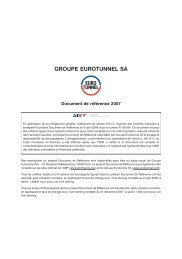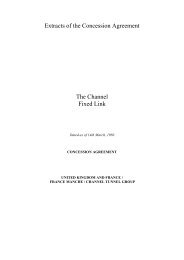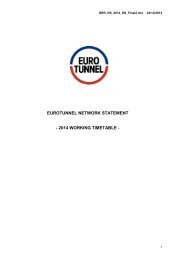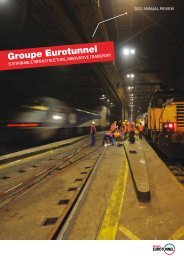2007 Reference Document for Groupe Eurotunnel SA PDF file size
2007 Reference Document for Groupe Eurotunnel SA PDF file size
2007 Reference Document for Groupe Eurotunnel SA PDF file size
Create successful ePaper yourself
Turn your PDF publications into a flip-book with our unique Google optimized e-Paper software.
6. DESCRIPTION OF EUROTUNNEL GROUP’S ACTIVITIESUnder the Railway Usage Contract, <strong>Eurotunnel</strong> Group recorded revenues totaling 262 million euros (pro <strong>for</strong>ma) in<strong>2007</strong>. The ending of the MUC mechanism as from the end of November 2006 represented a revenue loss <strong>for</strong><strong>Eurotunnel</strong> Group of 94 million euros in <strong>2007</strong> compared to 2006 (recalculated at the <strong>2007</strong> average exchange rate).EurostarThe Eurostar service is operated jointly by Eurostar (UK) Limited, the SNCF and the SNCB. Eurostar (UK) Limited isheld by London and Continental Railways Limited (‘‘LCR’’). Inter-Capital and Regional Railways Limited, in which theSNCF, the SNCB, British Airways and National Express Group hold equity interests, operates Eurostar (UK) Limitedunder a management contract.Eurostar currently transports passengers via direct train services between Paris and London in about two hours andfifteen minutes and between Brussels and London in about one hour and fifty minutes. In <strong>2007</strong> Eurostar had 73% ofthe Paris-London passenger market and 72% of the Brussels-London passenger market (Sources: BRB,SNCF, CAA).At present, Eurostar has a minimum of 17 scheduled departures on weekdays in each direction between Paris andLondon and 10 daily trains in each direction between London and Brussels, with additional or fewer departures atthe end of the week depending on the particular day and destination. Some trains make intermediate stops atEbbsfleet or Ash<strong>for</strong>d International in the United Kingdom and at Calais-Fréthun or Lille-Europe in France. Eurostaralso runs trains to Disneyland Paris and a seasonal direct service from London and Ash<strong>for</strong>d to Bourg-Saint-Mauricefrom December to April and to Avignon from July to September.The number of Eurostar passengers using the Tunnel increased by 5% between 2006 and <strong>2007</strong> (source: Eurostar).For more details, see chapter 9 of this <strong>Reference</strong> <strong>Document</strong>.Eurostar was able to benefit from the construction of the high-speed line between London and <strong>Eurotunnel</strong> Group’sBritish terminal. The construction of this line has been divided into two sections. The first links the Tunnel toFawkham Junction in northern Kent, and the second links Fawkham Junction to the new St Pancras internationalterminal in central London.The first section came into service in September 2003. The second came into service on 14 November <strong>2007</strong>. Thisline reduces the transit time between Paris and London or Brussels and London by around twenty minutes. At thattime, the entirety of the two sections were renamed ‘‘HS1’’ (or ‘‘High Speed One’’). In addition to the reducedjourney time, the operators of the Eurostar consider that their customer catchment area will be widened by the newstation at London St. Pancras which will improve connections to the North of England and by the Ebbsfleet stationlocated near the large motorway around London (the M25).Through Railfreight ServicesThe Through Railfreight Service between continental Europe and the United Kingdom is operated by SNCF andEWS on behalf of BRB. Three different types of freight train use the Tunnel:intermodal trains (3) , made up of wagons carrying containers and swap bodies;conventional trains carrying palleted goods, automotive components and bulk loads in enclosed wagons or inadapted wagons (tankers, plat<strong>for</strong>ms etc.); andtrains with specialized wagons <strong>for</strong> transporting new cars.Goods trains are in competition with most of the other modes of freight transport in operation between continentalEurope and the United Kingdom. Intermodal train services compete directly with road transport and maritimetransport on container ships. Intense competition in the cross-Channel freight market between road haulagecompanies, especially companies based in continental Europe, puts constant pressure on freight rates, making itmore difficult <strong>for</strong> the railway companies to compete. The goods transported by freight trains are mainly heavy, lowvalue items <strong>for</strong> which speed of delivery is not generally a primary consideration.(3)Intermodal: movable containers or cases carried by train from one terminal to another, then transferred to another mode of transport (boat,road, etc.)25







